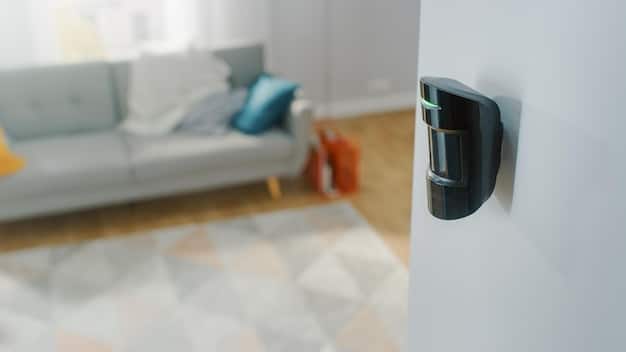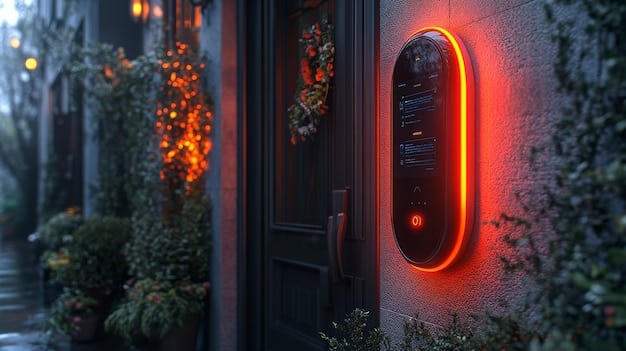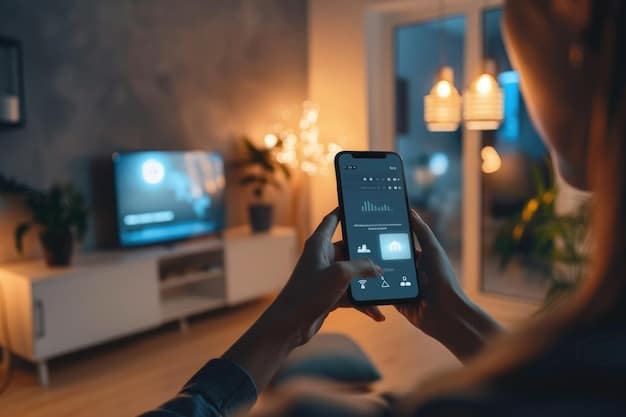Best Home Security Upgrades: Smart Tech Under $400

Upgrading your home security no longer requires a large budget. Smart, interconnected devices now allow effective protection for under $400.
You can integrate surveillance, access control, and notifications into a cohesive system. This ensures comprehensive protection without overspending.
Affordable smart tech has made home security accessible. Advanced features are no longer reserved for luxury setups or complex installations.
The Evolution of Home Security: Smart and Accessible
Home security has evolved from basic alarms to connected smart networks. These devices are user-friendly and can be managed via smartphone apps.
Technology advancements allow homeowners to monitor and control their property remotely. This shift empowers users to take charge of their safety.
The market now offers devices that integrate seamlessly. Real-time video, remote access, and notifications are all possible on a limited budget.
From Traditional Alarms to Connected Ecosystems
Traditional alarms required wiring and professional monitoring. Smart devices are wireless and easily configurable for DIY installation.
Alerts are sent directly to your smartphone. You gain control without relying on third-party monitoring services.
Smart security eliminates recurring monthly fees. Remote access, flexible setup, and self-management make it cost-effective and practical.
The Rise of Integrated Protection
Modern smart devices combine multiple functionalities. A video doorbell acts as a camera, intercom, and motion sensor.
Smart locks include temporary codes, activity logs, and remote access. Each device contributes to a unified security ecosystem.
This integration enhances overall home protection. Devices work together to provide layered security affordably.
Smart Device #1: The Video Doorbell – Your First Line of Defense
A video doorbell guards your front door, providing real-time monitoring and two-way audio. It is essential for under $100.
It sends alerts to your smartphone when someone approaches. Live video allows communication or deterrence from a distance.
This device acts as a visual deterrent. Package theft and unexpected visitors can be monitored instantly.
Key Features to Look For
1080p HD video ensures clear identification, day or night. Motion detection reduces false alarms from passing cars or pets.
Two-way audio allows immediate communication with visitors. Night vision provides visibility in low-light conditions.
Cloud storage helps review recordings later. Reliable performance ensures consistent monitoring and protection.
Popular Affordable Models

Brands like Ring, Wyze, and Eufy offer video doorbells under $100. Battery-powered options simplify installation for DIY users.
These models integrate well with smart ecosystems. They provide core security functionalities without overspending.
Archived footage adds value. In case of theft or break-ins, recordings serve as vital evidence for authorities.
Smart Device #2: Wireless Security Cameras – Expanding Your Vigilance
Wireless cameras monitor additional areas of your property. They cost less than $75 per unit and offer indoor/outdoor coverage.
They connect to Wi-Fi, sending live feeds and alerts directly to your phone. Placement flexibility ensures optimal surveillance.
Multiple cameras create a robust security network. Backyards, side doors, and garages can all be monitored easily.
Essential Capabilities for Affordable Cameras
1080p HD video captures clear images. Wide-angle lenses provide broader coverage with fewer cameras.
Night vision ensures visibility after dark. Two-way audio enables communication when necessary.
Local storage via SD card reduces recurring fees. Adjustable motion detection minimizes false alarms effectively.
Strategic Placement Tips
Place outdoor cameras on entry points, driveways, and secluded areas. Keep cameras high to prevent tampering.
Indoor cameras cover main living spaces, hallways, or rooms with valuables. Ensure they are within Wi-Fi range.
Avoid harsh sunlight or weather exposure for non-outdoor cameras. Correct placement maximizes performance and reliability.
Smart Device #3: Smart Plugs and Automated Lighting – Deterrence Through Presence
Smart plugs convert any device into a controllable smart device. They cost under $30 per multi-pack.
Automated lighting simulates occupancy, deterring intruders. Wi-Fi-enabled bulbs like Philips Hue or Sengled work without hubs.
Scheduling lights or linking to motion sensors creates dynamic patterns. Your home appears occupied even when empty.
How Automated Lighting Enhances Security
Lights can turn on/off at varying times. “Vacation mode” randomizes schedules to reduce predictability.
Remote control allows instant activation if motion is detected. Integration with cameras can trigger simultaneous lighting responses.
Voice assistant integration adds hands-free operation. This enhances deterrence and convenience for homeowners.
Affordable Options and Integration

TP-Link Kasa, Meross, and Wyze provide robust smart plug options. Wi-Fi bulbs eliminate the need for additional hubs.
Multiple plugs or bulbs stay within budget. Integration with sensors or cameras creates proactive alerts.
Automation improves safety and convenience. Lights can turn on in emergencies or when entering a room.
Smart Device #4: Window/Door Sensors – Immediate Intrusion Alerts
Window and door sensors cost around $25-$50 per multi-pack. They alert you the moment a door or window is opened.
These devices consist of two magnetic parts; breaking the connection triggers an alert. Notifications are sent instantly to your smartphone.
Immediate alerts allow you to act quickly. You can contact authorities or trigger other smart home actions for a fast response.
Types and Features to Consider
Most common are magnetic contact sensors, which are reliable and easy to install. Advanced models may detect vibration or glass breakage.
Choose sensors that integrate with a central hub or smartphone app. Long battery life is essential for consistent, low-maintenance performance.
Key features include easy peel-and-stick installation, instant alerts, and hub compatibility. These ensure integration with your overall smart home system.
Integration with Your System
Sensors work best when integrated with other smart devices. A triggered sensor can turn on lights or activate cameras simultaneously.
It can send push notifications to your phone and family members. This layered approach strengthens your home’s security network.
Brands like Aqara, Wyze, or SmartThings offer cost-effective, reliable, and compatible sensor packs. Strategic placement enhances perimeter protection and real-time awareness.
Budget Breakdown and Synergistic System Building
A full setup under $400 is feasible with careful selection. Prioritize devices with maximum value and minimal extra features.
Video doorbell: $70-$100. Wireless cameras: $100-$150. Smart plugs/lighting: $30-$60. Sensors: $50-$70.
Remaining budget covers accessories like memory cards or batteries. Strategic purchases maximize security without overspending.
Building a Synergistic System
Devices work together seamlessly as a connected network, with the video doorbell acting as the frontline while cameras provide coverage over broader areas of the property.
Smart plugs and lighting simulate occupancy, deterring intruders. Sensors trigger alerts for direct breaches.
Layered system ensures each device contributes to overall protection. Integration amplifies effectiveness.
Choosing Your Ecosystem
Some devices work best within brand ecosystems like Wyze. Others support IFTTT for cross-brand integration.
Compatibility ensures seamless communication between devices. Avoids operational issues and simplifies management.
A connected ecosystem improves response and monitoring. Smart investments enhance home security affordably.
Maximizing Your Security: Beyond the Devices
Acquiring the right smart devices is essential, but maximizing home security under $400 requires effective use. Combining technology with smart habits enhances protection significantly.
A strong system is actively maintained and monitored. Understanding your devices and adopting good practices increases overall security.
Simple, low-cost actions complement your tech investments. Together, these strategies create a robust and resilient home defense network.
Optimizing Device Usage
After installation, take time to explore all features thoroughly. Adjust motion zones on cameras and doorbells to reduce false alerts.
Customize notification settings to balance awareness and prevent alert fatigue. Schedule lights to mimic natural occupancy.
Knowledge of your system ensures maximum utility. Proper use helps get the most out of your smart home investment.
Best Practices for Home Security
Basic practices complement smart devices effectively. Lock doors and windows to create the first line of defense.
Secure valuables out of plain sight and maintain outdoor lighting. These simple steps reduce risks of opportunistic intrusions.
Foster community awareness and manage mail/packages. Knowing neighbors and hiding deliveries creates a safer, monitored environment.
The Future of Affordable Smart Home Security
Smart home security is becoming more affordable, intelligent, and interoperable. High-end capabilities are now available in budget-friendly devices.
Technology advances allow homeowners to access powerful, DIY solutions. Devices are easier to manage, offering proactive and integrated protection.
This evolution ensures even average homeowners can create comprehensive security. Affordable devices now rival features that were once premium.
Key Trends to Watch
AI-powered analytics will make cameras smarter, distinguishing pets, people, or packages. False alarms will be reduced without subscriptions.
Matter and Thread connectivity allow devices from different brands to work together seamlessly. Integration becomes simpler and more reliable.
Longer battery life and energy-efficient sensors will reduce maintenance. Environmental sensors for smoke, flood, or CO will create complete safety networks.
Impact on Homeowners
Sub-$400 systems will become more sophisticated while remaining affordable. Installation and management will continue to be simple and intuitive.
Competition drives prices down, making advanced security accessible to more households. Users will gain greater control and protection.
Privacy and local storage improvements give homeowners peace of mind. Security will shift from reactive to proactive, integrated into daily life.
| Key Component | Brief Benefit |
|---|---|
| 🔔 Video Doorbell | See, speak, and deter visitors at your door. |
| 📹 Wireless Cameras | Monitor key indoor/outdoor areas remotely. |
| 💡 Smart Plugs/Lights | Simulate occupancy to deter potential intruders. |
| 🚪 Window/Door Sensors | Receive instant alerts for unauthorized access. |
Frequently Asked Questions About Smart Home Security Upgrades
Yes, many smart security devices are highly reliable for self-monitoring. They send instant alerts to your smartphone, allowing you to quickly assess situations and decide on appropriate action, such as contacting emergency services. While professional monitoring adds a layer of outsourced response, self-monitoring with quality devices provides significant protection and immediate awareness.
Most smart security devices, especially those designed for budget-conscious consumers, are engineered for easy DIY installation. They often involve simple mounting, app-based setup, and Wi-Fi connectivity. No specialized tools or electrical wiring knowledge are typically required for basic setup, empowering homeowners to enhance their security independently.
Privacy is a valid concern. To mitigate risks, choose reputable brands known for strong encryption and data security. Position cameras carefully to only monitor your property, avoid public spaces, and be mindful of where footage is stored (local vs. cloud). Regularly review privacy settings and consider devices with local storage options to minimize data transmission.
The power consumption of most modern smart security devices is relatively low. Video doorbells and cameras typically use minimal electricity, especially when in standby mode. Smart plugs actually help save energy by allowing you to turn off appliances remotely. Overall, any increase in your electricity bill from these devices would be negligible.
Smart devices offer several advantages over traditional systems, including lower upfront costs, no mandatory monthly fees (for basic functions), flexible installation, and remote access via smartphone. While traditional systems often include professional monitoring, smart setups provide immediate, direct control and notification, empowering homeowners with greater autonomy over their security decisions.
Conclusion
Upgrading your home security doesn’t have to feel overwhelming or expensive. With a few smart choices, such as a video doorbell, wireless cameras, smart plugs, and door or window sensors, it’s possible to build a reliable system for under $400.
This setup delivers more than just surveillance and instant alerts; it also acts as a strong deterrent to potential threats. The result is greater safety, along with the peace of mind that your home is always protected.
Modern devices stand out for their accessibility and simple installation. They empower homeowners to monitor and control their property anytime, making smart technology a cost-effective way to safeguard what matters most.